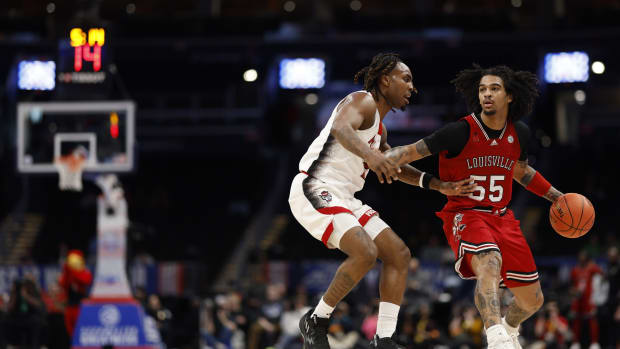Maryland's Confounding NCAA Tournament Case: 5–9 in the Big Ten, Yet Squarely on the Bubble
On first glance, Maryland men's basketball’s 72–59 win over Minnesota on Sunday night doesn’t seem to overly move the needle.
With the victory, the Terps improved to 5–9 in Big Ten play and 10–10 overall against Division I competition (they also have a win over Division II Wingate). With no top-100 wins out-of-conference, it’s hardly a record that typically suggests anything close to “NCAA tournament team.” But in this unprecedented year, it might be a résumé that ultimately says it.
Believe it or not, Maryland is firmly on the bubble for March Madness, and Sunday’s win over Minnesota—which came exactly one month out from Selection Sunday—was a critical step toward Indianapolis.
The Terrapins, who are led by veterans Darryl Morsell, Aaron Wiggins, Eric Ayala and Donta Scott, entered the weekend as one of the “First Four Out” on the Bracket Matrix average (meaning not currently in the field, but in position as one of the next four teams to step in), and in the same category in Sports Illustrated’s latest projected field.
How, you ask, are the Terrapins anywhere close to an at-large bid with a .357 winning percentage and 10th-place standing in-conference? By putting together one of the most bizarre recent résumés, in the nation’s deepest league, to put themselves on a crash course with what could become a heavily-scrutinized case for the tournament selection committee.
After Sunday's win, Maryland rose to 36th in the NCAA NET rankings—higher than the likes of Missouri, Xavier, Oklahoma State, Clemson, Oregon, UCLA, Indiana and North Carolina—and 35th on KenPom. Normally, those rankings for a power-conference team would have it safely enough in the field of 68. Then again, normally, those rankings suggest an overall record better than .500. So what’s going on here?
Consider this: Of Maryland’s 20 Division I games this season, a whopping 14—or 70%—currently qualify as Quadrant 1 under the NCAA’s NET rankings. Quad 1 games are defined as one of three things: a home game against a team in the top 30 of the NET, a neutral-court game against a team in the top 50, or a road game against a team in the top 75. Thanks to playing in a historically strong Big Ten, including a brutal stretch that at one point saw Mark Turgeon’s team face a ranked opponent in nine of 11 D-I games, the Terps have had plenty of opportunities to build their résumé.
Four of those games against ranked opponents turned into signature wins: on the road at Illinois, Wisconsin and Minnesota, and at home against Purdue. That’s given Maryland a unique 4–10 record in Quad 1 games, while its Sunday home win over the Golden Gophers improved its Quad 2 record to a grand total of … 1–0 (it’s a combined 5–0 against Quad 3/Quad 4). Only eight teams nationally have more Quad 1 wins than the Terps, and all are safely NCAA tournament-bound.
Right now (keep in mind that the NET ranking is updated daily, and therefore a past game’s classification is always malleable), no one in the country has played more Quad 1 games than the Terrapins’ 14. The nation’s two undefeated teams, Gonzaga and Baylor, have combined to play 13. The only other team to play more than 11 is Northwestern, with 12, and the tail-spinning Wildcats are in the middle of an 11-game losing streak.
While a 5–9 conference record and 10–10 overall mark might currently be a tough pill for the selection committee and hoops fans at large to swallow, Maryland’s path to dancing, and possibly even breathing easy on Selection Sunday, is clear. Of its final six regular season games, just one—at Rutgers—is positioned to be Quad 1. Its other five range from Quad 2 to Quad 3, including back-to-back games in College Park against 5–12 Nebraska this week that will be quietly crucial, as a loss in either would blemish what's otherwise been a résumé clean of bad losses. The hardest work is done—now, it's imperative the Terps start stacking victories, and that includes the need to win two straight conference games for what would be the first time this season.
KenPom predicts Maryland to have a greater than 50% chance to win in five of its final six, and sweeping all five of those would give it a 10–10 mark in the Big Ten and 15–11 record overall (not counting the Big Ten tournament), all while playing one of the nation’s toughest schedules. Sounds a lot more palatable, right?
...But what if the Terps don't go 5–1 over the next three weeks? What if instead of 10–10 in the Big Ten, they finish 8–12, with a first-game Big Ten tourney exit? Fire up the debate machine for what could be another round of everyone's favorite topic: Contentious bubble discussion. Should a Maryland team with four or five Quad 1 wins—in upwards of 14 opportunities—but a losing conference record be valued more than a mid-major that might have only one, or even zero, Quad 1 wins but a sterling overall mark?
It’s an annual debate that is often won—in the eyes of the selection committee, at least—by the power-conference teams, to the chagrin of mid-major supporters everywhere. Three years ago, five men’s programs danced with 8–10 league records. In 2019, an Ohio State team that was 8–12 in the Big Ten and an Oklahoma team that was 7–11 in the Big 12 both made it; both also went on to win their first-round NCAA matchups. In Maryland's case, one figures that the strength of this year's Big Ten, which featured three of the committee's top five teams in Saturday's top 16 reveal, will be a point further in its favor.
Maybe the committee won’t have to answer that hypothetical in 2021 with Maryland. Or maybe this year’s “uninspiring Power 5 team vs. upstart mid-major” debate will come down to a different high-major. While the Terps are top 40 in the NET, Indiana is No. 51 with a 2–8 record against Quad 1. North Carolina, out of the ACC, is 1–6 against Quad 1 and No. 57 overall, while the Pac-12's Oregon is No. 47 and 2–2 in just four Quad 1 games. Of course, Quad 1 wins, and the NET in general, aren’t a be-all, end-all, which is one of the reasons all of the Hoosiers, Tar Heels and Ducks are currently in most bracketers’ fields of 68.
For now, though, a team with five wins in 14 conference games is, remarkably, very much alive in the at-large discussion. With the toughest part of its schedule behind it, all Maryland can do is work on straightening out that meager Big Ten record, lest it find itself at the center of perhaps the biggest at-large debate of the year.
More College Hoops Coverage From SI.com:
SI Cover Story: How Gonzaga Zagged
Magic Eight: One of These Teams Will Win the National Title
How Loyola Chicago Built on Its Cinderella Moment




